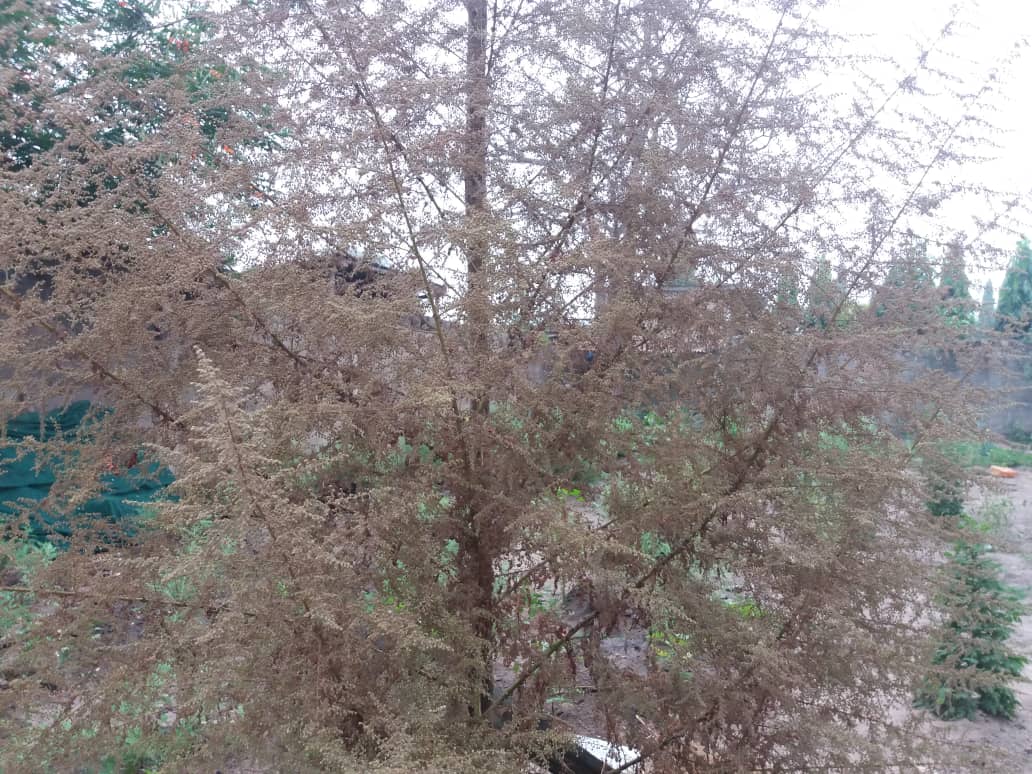Artemisia annua
Download in pdf
Taxonomy
Artemisia annua L. is a species of the Asteraceae family.
It has many local names including sweet wormwood, annual wormwood, sweet Annie, sweet sagewort, annual mugwort in English ; armoise annuelle, absinthe chinoise in French and mohlaswapatla in South Africa [1-2]
Its Chinese name is qinghao (青蒿) [2].
Origin and distribution
Artemisia annua is a plant native to the high plateaus of China, where it grows in steppe vegetation (40° north latitude between 1000 and 1500m altitude). It has spread widely throughout the world: North China, Europe, North Africa, North India, North Vietnam, USA, Argentina …
Over the last thirty years, it has been planted widely in East Africa and Madagascar (Kenya, Madagascar, Ethiopia, Tanzania …), Central Africa (Burundi, Cameroon, DRC, Rwanda, Sudan, Uganda …), West Africa (Burkina, Gambia, Mali, Nigeria, Senegal, Togo …) and South America (Brazil, Peru, Colombia) to a lesser extent. [1,3,4]
Botanical description
The morphology of Artemisia annua varies enormously from one plant to another.
- An annual herbaceous plant forming bushes that can exceed 3 m in height. Potentially biennial [1,4,6].
- Root system consisting of a short taproot and numerous secondary roots [4].
- Usually composed of a very hard single upright fibrous stem, occasionally several stems, with alternating branches that can reach a level higher than n+4 (quaternary branches) [3,4].
- Various ports are possible depending on the type of branching (slender, pyramidal, globular) [4].
- Stems are often ridged and glabrous (hairless) – rarely smooth and hairy – and can be red, yellow, brown or green in colour [4,6,7].
- The main stem and the first branches become lignified with age (become “hard as wood”) [3,4].
- When the plant is pruned, the buds at the base of the main stem break open and produce secondary stems [4].
- Alternating branches with petiolate (stalked) leaves from 1.5 to 10 cm long, very indented (bi-pinnate with linear serrated segments) [3,4].
- The leaves have a strong characteristic aromatic odour (fresh and bitter) due to the presence of glandular trichomes which secrete a volatile oil [2, 4,8].
- Alternate green leaves, generally glabrous (hairless) [7].
- Oval to triangular lamina, deeply cut. Leaf edge generally dentate [7].
- Inflorescences¹ (flower clusters) of green-yellow panicles appear at the top of the main stem and branches [3,4,8].
- Tiny, yellow flowers arranged in capitula² (flower-heads) 2-3 mm in diameter in the inflorescences [8].
- Fruits are smooth, ovoid, light-grey achenes³, 0.5 cm long [3].
- Each fruit contains a single, very small, brown, oblong seed (less than 1 mm, i.e. 10.000 to 14.000 per gram) [3,4].
- Pollination is mainly by wind, less frequently by insects [4,8].
- Fertilisation mainly allogamy (cross fertilisation between two distinct plants) [4].
- Plant fertility (number of achenes per inflorescence) is highly variable [4].
² Capitulum, pl. Capitula : cluster of small flowers
³ Achene : Dry one-seeded fruit that does not open to release the see

Ecological requirements
- Day length and sun
Artemisia annua is a short day plant which starts to flower (and hence stops its growth) when the day length falls below a critical threshold value: between 11.5 – 13.5 hours, depending on the variety and growing conditions [4].
Hydric stress (excess or shortage of water), high temperatures, the physical impact of water on the plant and the wind can also induce the start of flowering [4].
Upon return of more favorable conditions, if daylight duration is not too short, the plant can stop blossoming and resume growth [4].
It is a heliophilous plant, which likes full sun when sufficiently supplied with water [4].
- Temperature
Germination of seeds: from 7°C [1].
Optimal average growth temperature: 20-25°C [1].
Growth slows during the cold dry season [4].
The total temperature/days above the 10°C threshold must lie between 3500 and 5000°C to ensure good plant growth [1].
- Water
Artemisia annua requires significant amounts of water during the initial growth phase (young plants) but resists better to hydric stress thereafter. It requires a minimal rainfall of 600 to 650 mm/year to ensure growth. [9]
- Soil
Artemisia annua will grow best in not too heavy soils (i.e. sandy) with a pH between 5.5 et 7.5. It can grow in soil with pH below 5.5 but as a result will produce less biomass. [3]
It requires well drained soil as it does not tolerate waterlogging. [1].
Important: it is always possible to circumvent any adverse local conditions by selecting better suited varieties
Phenology
6 stages of development:






There are overlaps of stages 3, 4, 5 and 6 depending on the parts of the plant [4].
Cycle duration varies according to plant variety and growing conditions. For this reason, it is important to identify optimum varieties and growing periods for your site. (See First Trial sheet:Which cultivar and which period?)
Bibliography
1. World Health Organisation. WHO monograph on good agricultural and collection practices (GACP) for Artemisia annua L. 2006. http://www.who.int/malaria/publications/atoz/9241594438/en/
2. Africa Museum (Base Prélude) https://www.africamuseum.be/fr/research/collections_libraries/biology/prelude/results?keywords=artemisia%20annua®ion=2
3. Alexandre Sanner, L’Artémisinine et ses dérivés. Apports de la médecine traditionnelle chinoise dans la lutte contre le paludisme chimiorésistant et perspectives contemporaines, Université de Lorraine, Faculté de médecine de Nancy. 2008. http://docnum.univ-lorraine.fr/public/SCDMED_T_2008_SANNER_ALEXANDRE.pdf
4. Mergeai Guy. Lecturer-researcher at Gembloux Agro-Bio Tech (Faculty of Agronomic Sciences of the University of Liège). Observations reported.
5. Aftab, T. et al. Artemisia annua – Pharmacology and Biotechnology, Berlin, Heidelberg. Springer Berlin Heidelberg. 2014.
6. EcoCrop, consulted online at https://www.prota4u.org/database/protav8.asp?h=M4&t=Artemisia,annua&p=Artemisia+annua
7. eFlora of North-America, consulted online at http://worldfloraonline.org/taxon/wfo-0000083255
8. Blanc B., Weniger B., Nicolas J.-P. Réflexions autour de la culture d’Artemisia annua et de la production d’artémisinine. 2008. http://www.jardinsdumonde.org/wp-content/uploads/2016/03/R%C3%A9flexions-autour-de-la-culture-Artemisia-annua-Barbara-Blanc-Bernard-Weniger-Jean-Pierre-Nicolas.pdf
9. Ellman, A. Cultivation of Artemisia annua in Africa and Asia. Outlooks on Pest Management. 2010;21(2);84-88.
10. Ferreira, J.F.S. et al. Cultivation and genetics of Artemisia annua L. for increased production of the antimalarial artemisinin. Plant Genetic Resources: Characterization and Utilization. 2005;3(2);206-229. https://core.ac.uk/download/pdf/85211898.pdf










